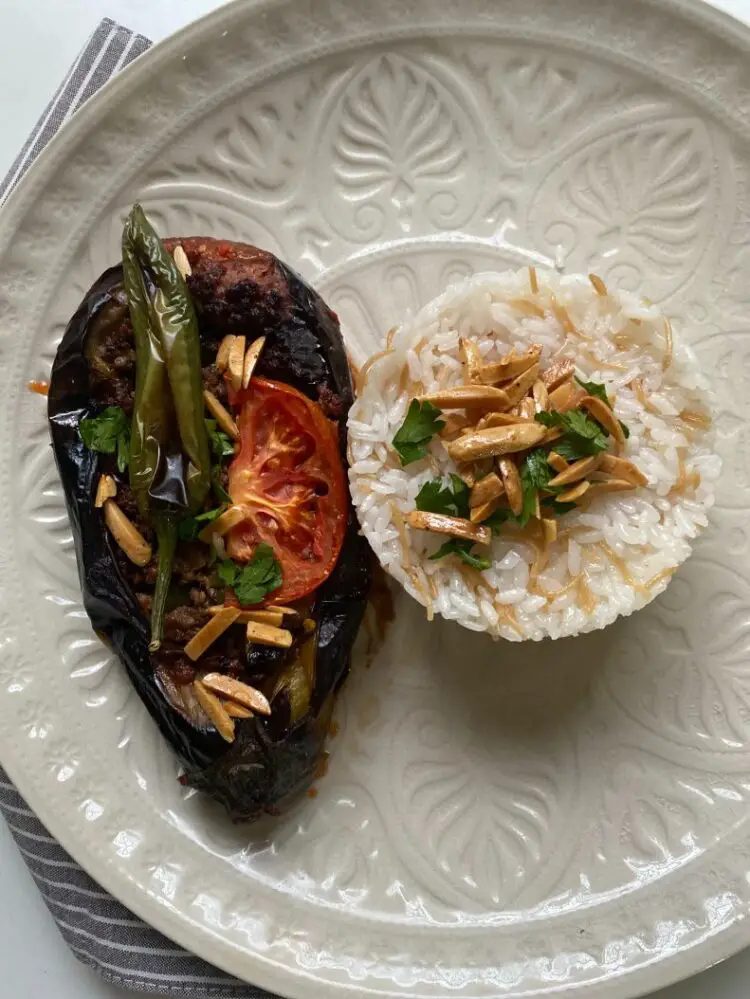Eggplant is a versatile vegetable that can be prepared in many delicious ways without deep-frying. There are numerous healthy and flavorful cooking methods for eggplant that avoid frying, including baking, grilling, sautéing, and more. The key is finding alternatives that lend the same tender and creamy texture achieved through frying.
Popular techniques include baking eggplant slices after oiling and seasoning, griddling or grilling thick eggplant steaks or cubes, stewing diced eggplant in tomato sauce or curries, and sautéing cubed eggplant in olive oil. Eggplant also works well in casseroles, parmesan dishes, salads, kabobs, and more. With a few simple preparation tips like salting and proper cooking times, you can enjoy the richness of eggplant without the extra calories from frying, Experiment with global flavors and versatile serving styles to take your eggplant repertoire to the next level.
Roasting Eggplant Techniques
Roasting is one of the best ways to cook eggplant without frying. When eggplant is roasted, the high oven heat caramelizes the natural sugars, concentrating the flavor and giving it a melt-in-your-mouth texture. There are a few key steps to roasting eggplant perfectly:
- Preparation – Slice, cube or keep the eggplant whole. Brush slices or cubes with olive oil and season with salt, pepper, garlic, or herbs. ,
- Vessel – Roast on a baking sheet for slices or cubes. For whole eggplants, use a baking dish or pan. ,
- Oven Temperature – Roast at 400-425°F to caramelize and tenderize. Higher heat gives more browning.
- Cook Times – Roast cubes and slices for 15-30 minutes, turning once. Whole eggplants take 45-60 minutes.
- Doneness – Look for a golden brown exterior and a very tender interior. Poke with a fork to check softness.
The best eggplant for roasting is the large, oval Italian variety. But smaller Asian or slender varieties also work well. Roast eggplant as a side dish, in casseroles, as a spread, or toss into salads. The roasted flavor pairs perfectly with Mediterranean seasonings like garlic, basil, and oregano. ,
Roasting brings out the natural sweetness of eggplant, but it can also concentrate any underlying bitterness. To avoid bitter eggplant, look for ones with smooth, shiny skin and no brown spots. Press the flesh gently – it should bounce back without denting. Before roasting, you can also “sweat” slices by salting them and letting them drain to remove excess moisture.
The oven rack position affects browning and cook times. Place the eggplant on the top rack for maximum charring. For more even cooking, use the middle rack. For gentle roasting, use the bottom rack. Keep an eye on doneness and adjust cook times as needed based on your oven. , You can also finish roasting eggplant under the broiler for 1-2 minutes to caramelize any sauces or toppings.
Sautéing Eggplant Methods
Sautéing is a quick and easy way to cook eggplant without oil frying. By cooking the eggplant in a small amount of olive oil over high heat, you can achieve a tender interior and browned exterior. The key to sautéing eggplant perfectly includes:
- Cutting – Slice, dice, or cube the eggplant into uniform pieces. This ensures even cooking. Popular cuts are:
- Slices – 1/4 to 1/2 inch thick
- Cubes – 1/2 to 1 inch
- Oil – Use olive, vegetable, or avocado oil. 2-3 tablespoons is enough for 1 pound of eggplant.
- Pan – Use a large skillet or sauté pan. Non-stick works well to prevent sticking.
- Heat – Get the oil very hot before adding eggplant. Medium-high to high heat works best.
- Cooking – Sauté for 4-8 minutes per batch, stirring occasionally until browned and tender. Work in batches to avoid steaming.
- Seasoning – Salt and pepper eggplant before or after cooking. Add herbs, garlic, or spices for flavor.
The best eggplants for sautéing are the smaller Italian or Asian varieties. Larger eggplants may need salting to remove bitterness. Enjoy sautéed eggplant as a side dish, over pasta, on pizza, in stir-fries, or tossed into salads. The caramelized flavor pairs well with herbs like basil, oregano, and thyme.
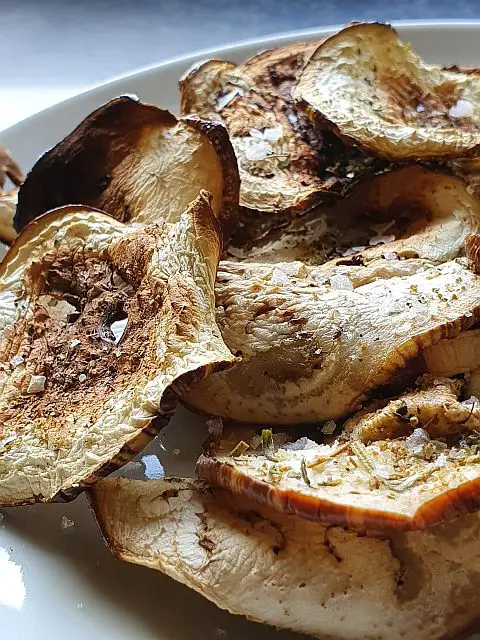
Making Stuffed Eggplant
Stuffing eggplant is a creative way to cook eggplant without frying. The eggplant acts as an edible vessel for a flavorful filling. Key tips for stuffed eggplant success include:
- Eggplant prep – Slice in half lengthwise and scoop out the flesh, leaving a 1/2 inch shell. Salt the shells to remove bitterness.
- Fillings – Popular options are ground meat, rice, vegetables, cheese, lentils, or beans. Season boldly.
- Assembly – Pack the filling into eggplant shells. Top with sauce and cheese if desired.
- Cooking method – Bake stuffed eggplants at 375°F for 30-40 minutes until tender. Or braise in sauce on the stovetop.
- Serving – Slice stuffed eggplants and top with extra sauce. Enjoy as a main dish or appetizer.
Italian, Chinese, and Middle Eastern cuisines have excellent stuffed eggplant dishes like moussaka, sheikh mahshi, and yu xiang qiezi, Get creative with fillings that match the seasonings.
To make stuffed eggplant even more appealing, you can experiment with different fillings and flavors. For example, try an Italian-inspired filling with ground beef, tomato sauce, and mozzarella cheese. Or, for a Middle Eastern twist, use a mixture of ground lamb, rice, and spices like cumin and cinnamon. Vegetarian options can include lentils, beans, or a mix of sautéed vegetables and grains. The possibilities are endless, so don’t be afraid to get creative with your stuffed eggplant recipes.
Presentation is also important when serving stuffed eggplant. After baking or braising, let the eggplant rest for a few minutes before slicing to make it easier to cut and serve. Garnish with fresh herbs like parsley or cilantro for a pop of color and added flavor. You can also drizzle a sauce or dressing over the top, such as a yogurt sauce, tahini, or tomato sauce. Stuffed eggplant makes for an impressive main dish or appetizer that is sure to impress your guests.
Grilled Eggplant
Grilling brings out delicious smoky flavors in eggplant without the need for frying. Follow these tips for perfect grilled eggplant:
- Prep – Slice eggplant lengthwise into 1/2-inch planks or crosswise into rounds. Brush with oil and season.
- Grill Temp – Use medium-high heat, 350-450°F. Avoid flaming.
- Technique – Grill for 4-5 minutes per side until tender. Use tongs to flip carefully.
- Charring – Some blackening adds a smoky flavor. But avoid burning.
- Done – Eggplant is done when very tender and lightly charred. Check often.
- Serving – Slice or cube grilled eggplant. Top on salads, pasta, and pizza.
Grilling brings out the natural sweetness of eggplant. Add zesty rubs or marinades for more flavor. For easy grilling, use eggplant slices in a grilling basket. Or thread cubes onto skewers. Grilled eggplant also works well layered into sandwiches or dips.
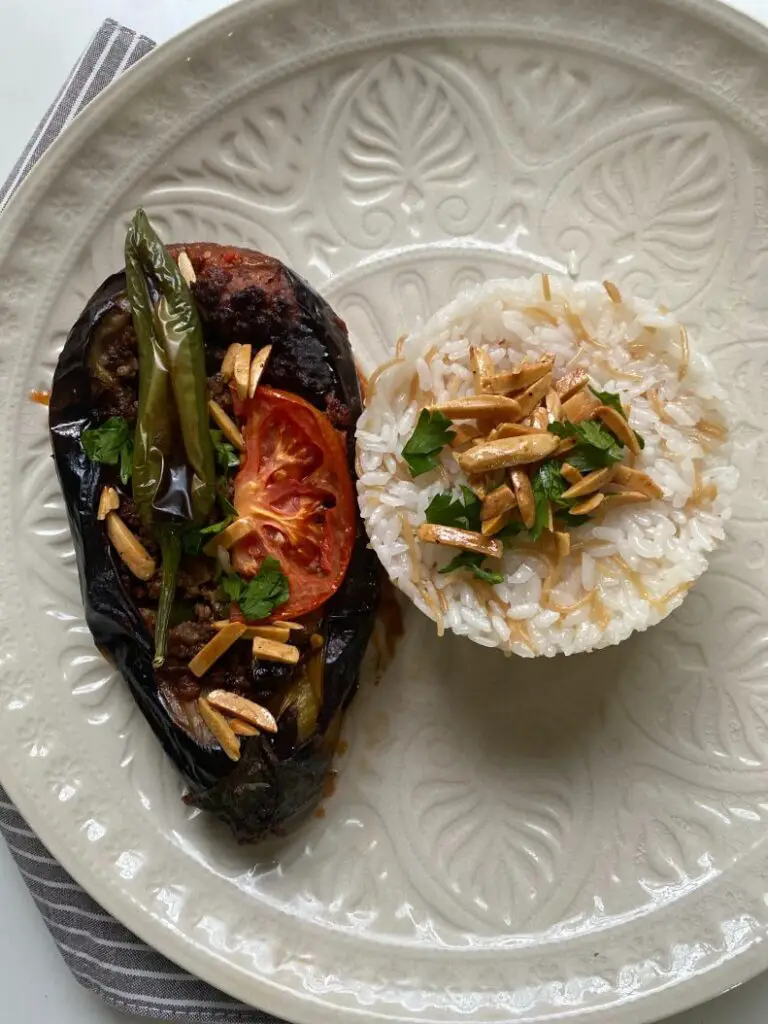
Making Baba Ganoush
Baba ganoush is a delicious roasted eggplant dip that is a staple of Middle Eastern cuisine. Follow these tips for perfect baba ganoush:
- Eggplant – Roast whole eggplants at 400°F until very soft, about 40 minutes. Allow to cool.
- Prep – Scoop out eggplant flesh and chop finely. Discard skins.
- Mix – Combine eggplant with tahini, lemon juice, garlic, and seasonings. Blend until smooth.
- Consistency – Add olive oil to reach the desired creaminess. Aim for a rich, velvety texture.
- Flavor – Finish with parsley, mint, or za’atar. Adjust lemon and garlic to taste.
- Serving – Top with olive oil and parsley. Serve as a dip with pita or spread on sandwiches.
Get creative with baba ganoush by adding roasted red peppers, pine nuts, or smoked paprika for flavor. It also makes a great sandwich spread or pizza topping. Baba Ganoush is best when made with fresh, local eggplants at peak season. Store leftovers in the refrigerator for up to one week.
Crafting a Delicious Eggplant Casserole
Eggplant casserole is the ultimate comfort food, blending layers of tender eggplant, rich tomato sauce, gooey cheese, and savory seasonings. This baked dish highlights the versatility of eggplant and transforms it into a hearty, crowd-pleasing meal.
When making eggplant casserole at home, start with fresh, firm eggplants free of blemishes. Slice them into rounds, cubes, or planks, about 1/4 to 1/2 inch thick. To reduce any potential bitterness, sprinkle the eggplant with salt and let sit for 30 minutes before rinsing and patting dry. This “sweating” process draws out excess moisture.
For best results, pre-cook the eggplant before assembling the casserole to cut down on baking time. Methods include sautéing, broiling, or roasting the slices until just tender. Pre-cooking intensifies the flavor and prevents a watery casserole.
Next, layer the ingredients in a casserole dish, starting with a base of tomato or cheese sauce. Add a layer of eggplant, then more sauce, shredded cheese, and seasonings like garlic, basil, and oregano. Repeat the layers until the dish is full, finishing with sauce and cheese. Popular cheese choices are mozzarella, ricotta, parmesan, or feta.
Bake the casserole at 350°F covered for 30-40 minutes until hot and bubbling. Then uncover and broil for 2-3 minutes to brown the cheese. Let rest for 5-10 minutes before serving so the flavors can meld.
Feel free to get creative with mix-ins like mushrooms, spinach, ground meat, or roasted veggies. Eggplant casserole also reheats wonderfully, making it a great meal prep dish. Serve it as a main course or side for a taste of Italy at home.
Preparing Eggplant Kabobs
Eggplant kabobs are a fun and flavorful way to cook eggplant without frying. Skewering eggplant with other vegetables or proteins creates a visually appealing and delicious dish perfect for grilling or roasting. Follow these steps for perfect eggplant kabobs:
- Eggplant – Choose firm, small to medium-sized eggplants for best results.
- Cutting – Cube eggplant into 1-1.5 inch pieces for even cooking.
- Marinating – Marinate eggplant cubes in olive oil, lemon juice, garlic, and herbs for 30 minutes to 2 hours.
- Skewering – Thread eggplant cubes onto skewers, alternating with other vegetables or proteins like bell peppers, onions, mushrooms, or chicken.
- Grilling – Grill kabobs over medium-high heat for 10-15 minutes, turning occasionally for even cooking.
- Roasting – Alternatively, roast kabobs in the oven at 425°F for 20-25 minutes, turning halfway through.
Eggplant kabobs are a versatile dish that can be customized with different marinades and seasonings. Try Mediterranean, Indian, or Asian-inspired flavors to suit your taste.
Serve eggplant kabobs as a main dish or appetizer with rice, salad, or pita bread. They’re perfect for outdoor gatherings, picnics, or a simple weeknight meal.
Adding Eggplant to Curries
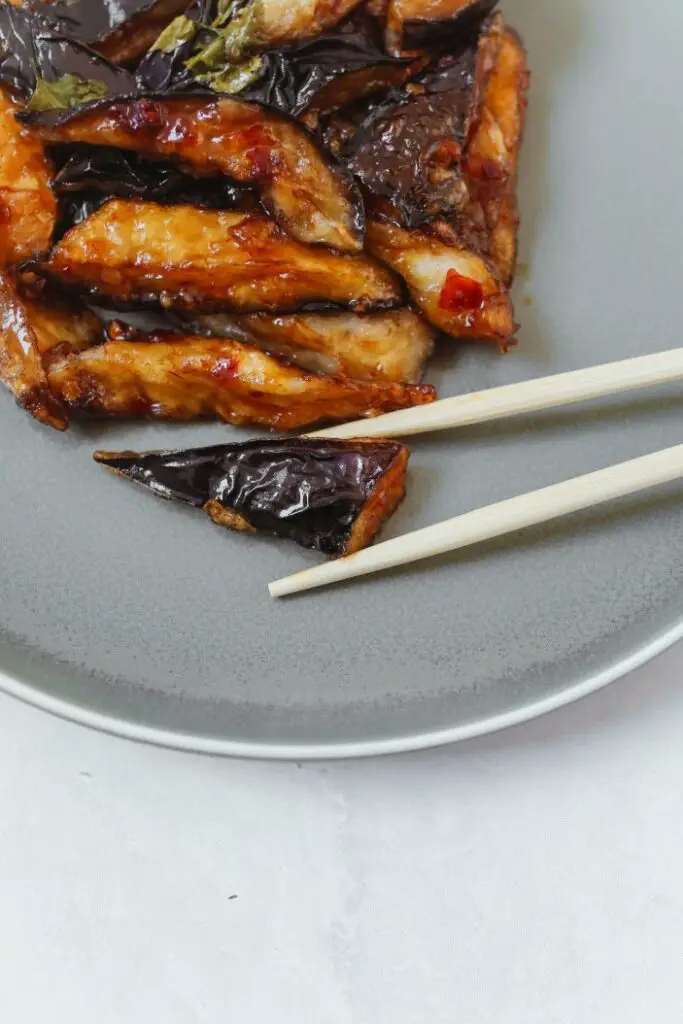
Eggplant is a versatile vegetable that adds depth and flavor to curries. It absorbs the rich spices and sauces, making it a perfect addition to various curry dishes. Follow these tips for incorporating eggplant into your favorite curry recipes:
- Eggplant Selection – Choose firm, small to medium-sized eggplants with smooth, shiny skin.
- Preparation – Cube eggplant into 1-1.5 inch pieces for even cooking.
- Cooking Methods – Sauté, steam, or simmer eggplant in curry sauce until tender.
- Curry Types – Add eggplant to Indian, Thai, or other Asian-inspired curries.
- Complementary Ingredients – Pair eggplant with other vegetables, legumes, or proteins like potatoes, chickpeas, or chicken.
- Seasonings – Enhance eggplant’s flavor with spices like cumin, coriander, turmeric, or garam masala.
Here are some popular eggplant curry dishes:
| Dish Name | Description |
|---|---|
| Eggplant Masala | A North Indian curry with a tomato-based sauce and aromatic spices. |
| South Indian Eggplant Curry | A coconut milk-based curry with tamarind and regional spices. |
| Thai Eggplant Curry | A fragrant curry with Thai basil, lemongrass, and coconut milk. |
| Eggplant and Potato Curry | A hearty curry with a spiced tomato sauce. |
| Eggplant and Chickpea Curry | A protein-packed curry with a rich, flavorful sauce. |
Experiment with different curry styles and ingredients to create a delicious eggplant dish that suits your taste.
Crafting Flavorful Eggplant Stews
Stewing brings out eggplant’s rich, meaty texture and absorbs the flavors of aromatic ingredients. The slow-cooking process allows the eggplant to absorb the rich flavors of the stew, creating a tender and delicious dish. Follow these tips for making delicious eggplant stews:
- Eggplant selection – Choose firm, fresh eggplants with smooth, shiny skin. Small to medium size works best.
- Prep – Wash, trim, and cut eggplant into 1-inch cubes or chunks. Consider salting and draining to reduce bitterness.
- Browning – For deeper flavor, brown eggplant pieces in oil before stewing.
- Liquid – Simmer eggplant in tomato sauce, coconut milk, broth, or water.
- Seasonings – Flavor stew with garlic, ginger, cumin, thyme, curry powder, or other spices.
- Additions – Cook eggplant with potatoes, chickpeas, lentils, ground meat, or stewed chicken.
- Finish – Garnish stew with parsley, cilantro, or green onions. Serve over rice.
Some popular global eggplant stew recipes include:
- Middle Eastern – With tomatoes, lamb, onions, cinnamon
- Indian – Curried eggplant and potato stew
- Caribbean – With salted codfish and hot peppers
- African – In a spicy tomato peanut sauce
When stewing eggplant, be sure to monitor the cooking time and adjust as needed to achieve the desired tenderness. Serve your eggplant stew over rice, couscous, or with crusty bread to soak up the flavorful sauce.
Experiment with different seasonings and ingredients to create a unique and satisfying eggplant stew that suits your taste buds.
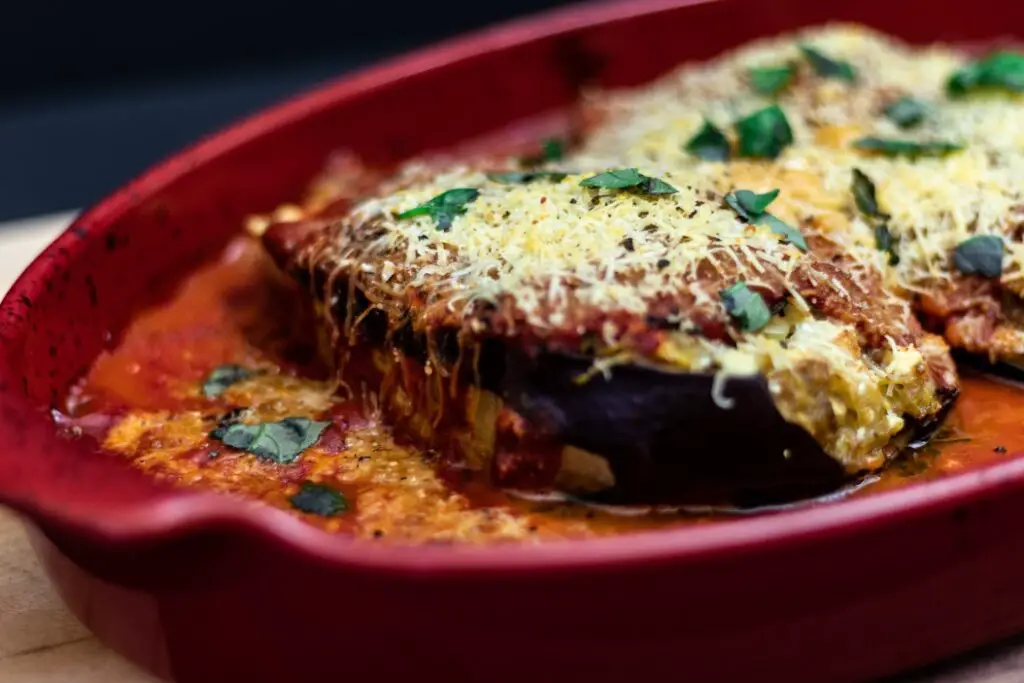
Cooking Eggplant in a Skillet
Cooking eggplant in a skillet is a quick and easy way to enjoy this versatile vegetable without frying. There are several methods to cook eggplant in a skillet, including pan-frying, sautéing, and stir-frying.
Pan-frying eggplant is a popular method that involves cooking sliced eggplant in a small amount of oil over medium-high heat. To pan-fry eggplant, follow these steps:
- Slice eggplant into 1/4 to 1/2 inch thick rounds or lengthwise into planks.
- Heat a skillet with a thin layer of oil over medium-high heat.
- Cook eggplant slices for 3-4 minutes per side until golden brown and tender.
Sautéing eggplant involves cooking cubed or sliced eggplant in a small amount of oil over medium-high heat. To sauté eggplant, follow these steps:
- Cut eggplant into 1-inch cubes or slices.
- Heat a skillet with 2-3 tablespoons of oil over medium-high heat.
- Cook eggplant for 4-8 minutes, stirring occasionally, until browned and tender.
Stir-frying eggplant is a method that involves quickly cooking small pieces of eggplant with other ingredients over high heat. To stir-fry eggplant, follow these steps:
- Cut eggplant into 1-inch cubes.
- Heat a wok or large skillet with oil over high heat.
- Add eggplant and other ingredients like onions, bell peppers, or proteins, and cook for 5-7 minutes, stirring constantly.
Whichever method you choose, remember to season your eggplant with salt, pepper, and your favorite herbs or spices. Cooking eggplant in a skillet is a simple and delicious way to enjoy this versatile vegetable in a variety of dishes.
Some popular eggplant skillet dishes include:
- Eggplant Parmesan – Pan-fried eggplant slices layered with marinara sauce and cheese.
- Eggplant Stir-Fry – Stir-fried eggplant with bell peppers, onions, and a savory sauce.
- Eggplant and Tomato Sauté – Sautéed eggplant with tomatoes, garlic, and fresh basil.
- Spicy Eggplant Skillet – Eggplant cooked with spicy peppers, onions, and a flavorful sauce.
Experiment with different seasonings and ingredients to create unique and satisfying eggplant dishes that suit your taste buds.
Preparing Eggplant for Cooking
Properly preparing eggplant before cooking is important for maximizing flavor and texture. Follow these tips when getting eggplant ready to cook:
- Washing – Rinse eggplant under cold water to clean off any dirt or debris1. Pat dry with paper towels.
- Peeling – Eggplant skins can be tough, so peel off the skin with a vegetable peeler or paring knife if desired.
- Trimming – Trim off the stem and bottom ends of the eggplant.
- Cutting – Slice, dice, or cut eggplant into desired shape based on the recipe. Uniform pieces allow for even cooking.
- Salting – Lightly salt-sliced eggplant and let sit for 30 minutes to draw out the bitterness. Rinse and pat dry.
- Draining – Place salted eggplant slices between paper towels to absorb excess moisture. This prevents sogginess.
Proper preparation is key for eggplant dishes with great texture and flavor. Always start with fresh, firm eggplant and prep according to your chosen cooking method.
Can any of the eggplant cooking methods be used as a main course for hosting a meal?
Yes, several eggplant cooking methods can be used to create easy main course dishes for hosting a meal. Grilling, roasting, stuffing, or even making eggplant parmesan are all great options for a delicious and satisfying main dish.
Reducing Bitterness in Eggplant
Eggplant can sometimes have a bitter taste. Here are some tips to reduce bitterness when cooking eggplant:
- Salting – Salt sliced eggplant and let sit for 30 minutes to draw out excess moisture and bitterness.
- Rinsing – After salting, rinse eggplant under cold water to remove drawn-out moisture.
- Drying – Pat eggplant slices dry with paper towels to remove excess rinsed liquid.
- Peeling – Remove the skin, which contains more bitterness than the flesh.
- Seeding – Scoop out and discard the seeds, another source of bitterness.
- Soaking – Soak eggplant in milk or lemon juice for 30 minutes to help extract bitterness.
- Cooking – Cooking eggplant thoroughly helps reduce inherent bitterness.
With a few simple preparation techniques, you can easily tame bitterness in eggplant for better flavor.
Dicing Eggplant
Dicing eggplant into small, uniform pieces helps it cook evenly. Follow these tips for dicing eggplant:
- Peeling – Peel off the skin first for smoother diced pieces.
- Trimming – Cut off ends and trim any curved areas.
- Halving/Quartering – Cut eggplant in half or quarters lengthwise for stability.
- Seed Removal – Use a spoon to scoop out the seedy interior.
- Sizing – For even cooking, keep diced pieces around 1 inch sized.
- Technique – Place eggplant firmly on a cutting board. Use a sharp knife to cut into uniform cubes.
- Shape – Keep pieces in a consistent size and shape for even cooking.
Dicing eggplant takes some knife skills, but is worth it for dishes like ratatouille, curries, or stir-fries. Evenly-sized pieces cook at the same rate.
Conclusion:
Eggplant is a versatile vegetable that can be prepared and cooked in many delicious ways. Proper preparation techniques like salting, rinsing, and drying can help reduce inherent bitterness and lead to better flavor. Cooking methods like pan-frying, sautéing, stewing, and grilling all allow you to highlight eggplant’s meaty texture and ability to absorb surrounding flavors. No matter which recipe you choose, eggplant is sure to add richness, heartiness, and visual appeal to both main dishes and sides.
With so many options for preparing and cooking eggplant, it’s easy to incorporate this healthy veggie into your regular recipe rotation. Try dicing eggplant for curries and stews, grilling slices for a meatless main, or pan-frying breaded cutlets. Stuff halved eggplants with flavorful fillings or skewer cubes for the grill. However you decide to cook eggplant, proper preparation is key. Follow techniques like salting and seed removal to prevent bitterness and achieve the best results.
Eggplant is affordable, readily available, and packed with nutrients like fiber, potassium, and antioxidants. Challenge yourself to prepare eggplant in new ways and explore dishes from around the globe. With a little creativity in the kitchen, the possibilities for preparing and cooking eggplant are truly endless.

